Papers by Katja Ignatieva
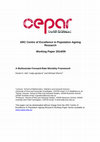
Social Science Research Network, 2014
Stochastic mortality models have been developed for a range of applications from demographic proj... more Stochastic mortality models have been developed for a range of applications from demographic projections to financial management. Financial risk based models build on methods used for interest rates and apply these to mortality rates. They have the advantage of being applied to financial pricing and the management of longevity risk. Olivier and Jeffery (2004) and Smith (2005) proposed a model based on a forward-rate mortality framework with stochastic factors driven by univariate gamma random variables irrespective of age or duration. We assess and further develop this model. We generalize random shocks from a univariate gamma to a univariate Tweedie distribution and allow for the distributions to vary by age. Furthermore, since dependence between ages is an observed characteristic of mortality rate improvements, we formulate a multivariate framework using copulas. We find that dependence increases with age and introduce a suitable covariance structure, one that is related to the notion of a minimum. The resulting model provides a more realistic basis for capturing the risk of mortality improvements and serves to enhance longevity risk management for pension and insurance funds.
Social Science Research Network, 2012
This paper investigates several crucial issues that arise when modeling equity returns with stoch... more This paper investigates several crucial issues that arise when modeling equity returns with stochastic variance. (i) Does the model need to include jumps even when using a nonaffine variance specification? We find that jump models clearly outperform pure stochastic volatility models. (ii) How do affine variance specifications perform when compared to nonaffine models in a jump diffusion setup? We find that nonaffine specifications outperform affine models, even after including jumps.
Institutions, Efficiency and Evolving Energy Technologies,34th IAEE International Conference,June 19-23, 2011, Jun 19, 2011

Social Science Research Network, 2012
This paper examines market concentration and stock returns on the Australian Securities Exchange.... more This paper examines market concentration and stock returns on the Australian Securities Exchange. We find that dominant companies operating in concentrated industries in Australia are able to generate significant risk-adjusted excess stock returns. Our results for Australian data are opposite to that found by Hou and Robinson (2006) for United States market data. Hou and Robinson reason that United States firms which operate in concentrated industries are insulated from competitive pressures, have lower levels of innovation (Arrow, 1962) and therefore experience lower profitability and stock returns. By contrast, the Australian data show a significant and positive relationship between concentration and innovation expenditure. Therefore, the excess stock returns of dominant companies in Australia are consistent with previous research linking innovation expenditure with excess stock returns. We hypothesize that the apparent contradiction of our results compared with Hou and Robinson (2006) for the United States market is resolved by an examination of the differences in size and competition in United States and Australian industries and the consequent differential ability of dominant companies in the two countries to generate monopoly rents and invest in 'Schumpeterian' (Schumpeter, 1942) innovation.
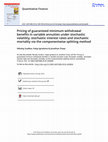
Quantitative Finance, Sep 3, 2018
This paper values guaranteed minimum withdrawal benefit (GMWB) riders embedded in variable annuit... more This paper values guaranteed minimum withdrawal benefit (GMWB) riders embedded in variable annuities assuming that the underlying fund dynamics evolve under the influence of stochastic interest rates, stochastic volatility, stochastic mortality and equity risk. The valuation problem is formulated as a partial differential equation (PDE) which is solved numerically by employing the operator splitting method. Sensitivity analysis of the fair guarantee fee is performed with respect to various model parameters. We find that (i) the fair insurance fee charged by the product provider is an increasing function of the withdrawal rate; (ii) the GMWB price is higher when stochastic interest rates and volatility are incorporated in the model, compared to the case of static interest rates and volatility; (iii) the GMWB price behaves non-monotonically with changing volatility of variance parameter; (iv) the fair fee increases with increasing volatility of interest rates parameter, and increasing correlation between the underlying fund and the interest rates; (v) the fair fee increases when the speed of mean-reversion of stochastic volatility or the average long-term volatility increases; (vi) the GMWB fee decreases when the speed of mean-reversion of stochastic interest rates or the average long-term interest rates increase. We investigate both static and dynamic (optimal) policyholder's withdrawal behaviours; we present the optimal withdrawal schedule as a function of the withdrawal account and the investment account for varying volatility and interest rates. When incorporating stochastic mortality, we find that its impact on the fair guarantee fee is rather small. Our results demonstrate the importance of correct quantification of risks embedded in GMWBs and provide guidance to product providers on optimal hedging of various risks associated with the contract.
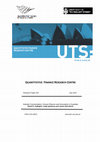
Accounting and finance, Mar 4, 2014
This paper examines market concentration and stock returns on the Australian Securities Exchange.... more This paper examines market concentration and stock returns on the Australian Securities Exchange. We find that dominant companies operating in concentrated industries in Australia are able to generate significant risk-adjusted excess stock returns and excess profits on sales (monopoly rents). Our results for Australian data are opposite to that found by Hou and Robinson (2006) for United States market data. Hou and Robinson reason that U.S. firms which operate in concentrated industries are insulated from competitive pressures, have lower levels of innovation (Arrow (1962)) and therefore experience lower profitability and stock returns. The high stock returns of dominant companies in Australia is consistent with Schumpeter's (1942) theory of innovation where monopoly excess profits are necessary to fund corporate innovation. We hypothesize that the apparent contradiction of our results compared with Hou and Robinson (2006) for the United States market is resolved by an examination of the differences in size and competition in U.S. and Australian industries and the consequent differential ability of dominant companies in the two countries to generate monopoly rents.
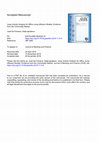
Journal of Banking and Finance, Feb 1, 2019
This study performs a joint analysis of jump activity for commodities and their respective volati... more This study performs a joint analysis of jump activity for commodities and their respective volatility indexes; it also compares the results thereof to those for equities. Exploiting a property of affine jumpdiffusion models (i.e., that a volatility index quoted on the market is an affine function of the instantaneous volatility state variable), we perform a test of common jumps for multidimensional processes to assess whether an asset and its volatility jump together. Applying this test to the crude oil pair USO/OVX, the gold pair GLD/GVZ, the S&P500/VIX, and three stock/volatility index pairs, we find strong evidence that these assets and their respective volatility indexes do not jump together. However, a copula analysis shows that for the equity index and individual stocks, there is a dependency between the jump sizes in the asset and in the volatility index. In contrast, for the commodity market, this dependency occurs only after decomposing the jump sizes that affect the asset into positive and negative components.

Studies in Nonlinear Dynamics and Econometrics, Mar 20, 2023
We propose a new state space model to estimate the Integrated Variance (IV) in the presence of mi... more We propose a new state space model to estimate the Integrated Variance (IV) in the presence of microstructure noise. Applying the pre-averaging sampling scheme to the irregularly spaced high-frequency data, we derive equidistant efficient price approximations to calculate the noise-contaminated realised variance (NCRV), which is used as an IV estimator. The theoretical properties of the new volatility estimator are illustrated and compared with those of the realised volatility. We highlight the robustness of the new estimator to market microstructure noise (MMN). The pre-averaging sampling effectively eliminates the influence of the MMN component on the NCRV series. The empirical illustration features the EUR/USD exchange rate and provides evidence of a superior performance in volatility forecasting at very high sampling frequencies.
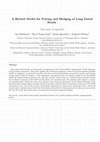
Applied Mathematical Finance, Jun 16, 2015
Long dated fixed income securities play an important role in asset-liability management, in life ... more Long dated fixed income securities play an important role in asset-liability management, in life insurance and in annuity businesses. This paper applies the benchmark approach, where the growth optimal portfolio (GOP) is employed as numéraire together with the real world probability measure for pricing and hedging of long dated bonds. It employs a time dependent constant elasticity of variance model for the discounted GOP and takes stochastic interest rate risk into account. This results in a hybrid framework that models the stochastic dynamics of the GOP and the short rate simultaneously. We estimate and compare a variety of continuous-time models for short-term interest rates using non-parametric kernel-based estimation. The hybrid models remain highly tractable and fit reasonably well the observed dynamics of proxies of the GOP and interest rates. Our results involve closed-form expressions for bond prices and hedge ratios. Across all models under consideration we find that the hybrid model with the 3/2 dynamics for the interest rate provides the best fit to the data with respect to lowest prices and least expensive hedges.

Social Science Research Network, 2017
This paper introduces a Generalised Additive Model (GAM) to link high frequency intraday (5-minut... more This paper introduces a Generalised Additive Model (GAM) to link high frequency intraday (5-minute) aggregate electricity demand in Australia to the time of the day and intra-day temperature. We show a superior model fit when using Daylight Saving Time (DST), or clock time, instead of the standard (solar) time. We also introduce the time weighted temperature model that relates instantaneous electricity demand sensitivity to temperature as a function of the daily activity cycle. The results on DST and time weighted temperature modelling are novel in the literature and are important innovations in high frequency electricity demand forecasting. The overall accuracy of the proposed GAM specification in predicting demand is comparable to the accuracy of the commercial demand forecasting model used by the Australian Energy Market Operator (AEMO). The parsimonious GAM model provides a solid foundation for the development of more elaborate models for forecasting high frequency electricity demand.
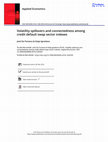
Applied Economics, Feb 6, 2018
This article studies volatility spill-over effects and market connectedness using daily data of c... more This article studies volatility spill-over effects and market connectedness using daily data of credit default swap spreads for U.S. companies over a period from 2007 to 2012. We quantify volatility spillovers by means of an unconditional analysis performed using the entire sample, and a conditional analysis which estimates the model using a rolling window. As our database contains the global financial crisis (GFC), we are able to determine how volatility spillovers spread in the economy during the recent market turmoil. Our unconditional results confirm that the Financials sector was a main contributor to the overall market volatility along with the Consumer Goods, Consumer Services and Basic Materials sectors. The conditional analysis clearly identifies that the Financials was the major feeding sector of volatility spill-over effects, and that the market volatility was successively driven by Technology and Basic Materials over a rather short period of time, followed by Consumer Goods and Consumer Services over a prolonged period of time. Our results illustrate indirect linkages between the sectors that conveyed shocks during the GFC.
Applied Economics, Aug 22, 2016
This article employs the copula approach to study the relationship between exchange rates and com... more This article employs the copula approach to study the relationship between exchange rates and commodity prices for large commodity exporters. Using data for the nominal exchange rates of four commodity currencies (Australian, Canadian and New Zealand dollars, and Norwegian krone) against the US dollar and the relevant country-specific commodity price indices, constructed on a daily basis, we find (1) a positive dependence between the values of commodity currencies and commodity indices, i.e. a commodity index increases when a respective currency appreciates and provides several explanations for this finding; (2) no major asymmetries in the tail dependence for most pairs of exchange rates and commodity indices and (3) a pronounced increase in the time-varying tail dependence following the global financial crisis.
We argue that not only the standard risk factors (size, book-to-market ratio) affect the average ... more We argue that not only the standard risk factors (size, book-to-market ratio) affect the average stock returns, but also the structure of the product market itself. We address the issue of competition on the Australian stock market, comparing it to the US stock market. In contrast o the US market, we find a significant evidence that companies operating in highly concentrated industries generate higher risk-adjusted returns than those operating in less concentrated (more competitive) industries. Regarding the standard risk factors, we find that average returns are positively related to the size of the company, and negatively related to book-to-market, which is the opposite to the US stock market as documented in previous studies.

Social Science Research Network, 2012
ABSTRACT The growth optimal portfolio (GOP) plays an important role in finance, in particular in ... more ABSTRACT The growth optimal portfolio (GOP) plays an important role in finance, in particular in derivative pricing, where it is employed as a num\'eraire portfolio, allowing to price contingent claims directly under the real world probability measure. This paper derives an extension of a time dependent constant elasticity of variance (TCEV) model which takes into account stochastic interest rate risk. This results in a hybrid framework that models the stochastic dynamics of the GOP and the short rate simultaneously. We estimate and compare a variety of continuous-time models for short-term interest rates using non-parametric kernel-based estimation. Taking interest rate dynamics into account, we show that the hybrid model remains highly tractable and fits well the observed dynamics of diversified equity indices and interest rates. Our results are important for pricing and hedging of various derivative products, allowing to derive closed-form solutions for standard derivatives. Across all models under consideration we find that the hybrid model with 3/2 dynamics for the interest rate provides the best fit to the data. It leads to the lowest prices and the least expensive hedges.

Purpose: Our study is aimed to give a better understanding of the price dynamics in regional elec... more Purpose: Our study is aimed to give a better understanding of the price dynamics in regional electricity spot markets in Australia. We examine the dependence structure between electricity spot prices and apply the results in risk management. Originality: We focus in particular on the dependence between regional prices and conduct a pioneer study on the use of copulas for capturing this dependence structure. Our study yields important insights with respect to joint price movements, extreme price outcomes and the impact of interconnection within the Australian electricity market. Design/Methodology/Approach: Our analysis is based on a GARCH approach to model time-varying volatilities of the marginal price series in the considered regions in combination with copulas to capture the dependence structure between the different markets. The performance of copula models is tested in risk management application where we estimate the Value-at-Risk for a stylized portfolios of holding electricity spot contracts in different markets. Findings: We find a positive dependence structure between prices from all of the considered markets with the strongest dependence is exhibited between markets that are well connected via interconnector transmission. The Student-t copula outperforms all other one-parametric copulas whereas the overall best results are obtained using mixture models due to their ability of also capturing asymmetric dependence in the tails of the distribution. Regarding Value-at-Risk applications, we find that due to the spiky and extreme volatile behaviour of electricity spot prices in the considered markets, none of the considered models could provide an appropriate specification of the risk. Still, overall the mixture copula model in combination with Student-t marginals performs best, while the Student-t copula yields results that are only slightly worse. Both models outperform the Gaussian copula model.2 page(s
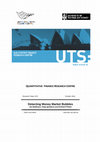
Journal of Banking and Finance, Feb 1, 2018
Using a range of stochastic volatility models well-known in the finance literature, we study the ... more Using a range of stochastic volatility models well-known in the finance literature, we study the existence of money market bubbles in the US economy. Money market bubbles preclude the existence of a risk-neutral pricing measure. Understanding whether markets exhibit money market bubbles is crucial from the point of view of derivative pricing since their existence implies the existence of a self-financing trading strategy that replicates the savings account's value at a fixed future date at a cheaper cost than the current value of the savings account. The benchmark approach is formulated under the real world probability measure and does not require the existence of a risk neutral probability measure. It hence emerges as the appropriate framework to study the potential existence of money market bubbles. Testing the existence of money market bubbles in the US economy we find that for all models the US market exhibits a money market bubble. This conclusion suggests that for derivative pricing and hedging care should be taken when making assumptions pertaining to the existence of a risk-neutral probability measure. Less expensive hedge portfolios may exist for a wide range of derivatives.
Energy Economics, Apr 1, 2022
Social Science Research Network, 2011
This paper deals with the estimation of continuous-time diffusion processes which model the dynam... more This paper deals with the estimation of continuous-time diffusion processes which model the dynamics of a well diversified world stock index (WSI). We use the nonparametric kernel-based estimation to empirically identify a square root type diffusion coefficient function in the dynamics of the discounted WSI. A square root process turns out to be an excellent building block for a parsimonious model for the WSI. Its dynamics allow capturing various empirical stylized facts and long term properties of the index, as well as, the explicit computation of various financial quantities.
The Energy Journal, Jul 1, 2020
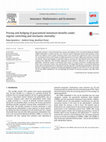
Insurance Mathematics & Economics, Sep 1, 2016
This paper presents a novel framework for pricing and hedging of the Guaranteed Minimum Benefits ... more This paper presents a novel framework for pricing and hedging of the Guaranteed Minimum Benefits (GMBs) embedded in variable annuity (VA) contracts whose underlying mutual fund dynamics evolve under the influence of the regime-switching model. Semi-closed form solutions for prices and Greeks (i.e. sensitivities of prices with respect to model parameters) of various GMBs under stochastic mortality are derived. Pricing and hedging is performed using an accurate, fast and efficient Fourier Space Timestepping (FST) algorithm. The mortality component of the model is calibrated to the Australian male population. Sensitivity analysis is performed with respect to various parameters including guarantee levels, time to maturity, interest rates and volatilities. The hedge effectiveness is assessed by comparing profit-and-loss distributions for an unhedged, statically and semi-statically hedged portfolios. The results provide a comprehensive analysis on pricing and hedging the longevity risk, interest rate risk and equity risk for the GMBs embedded in VAs, and highlight the benefits to insurance providers who offer those products.
Uploads
Papers by Katja Ignatieva